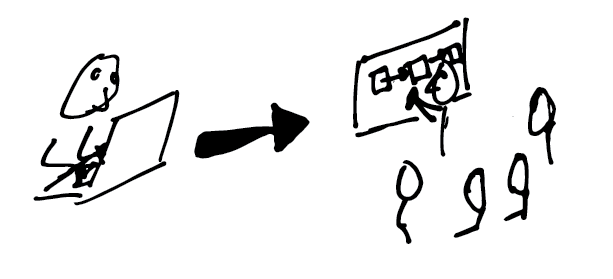You Are Your Own Best Hype Person
Learn how to accurately and effectively advocate for yourself and grow in your career by recording your accomplishments.
At some point in your career, you’re going to have to prove to someone that you’re worth it: worth hiring, worth promoting, worth the raise, worth taking a risk on. If you’re lucky, you might have someone who has seen your work first hand, who believes in you and can vouch for you.
 Gif of Blanche from TV show The Golden Girls laughing with the caption “Damn, I’m good.” (source)
Gif of Blanche from TV show The Golden Girls laughing with the caption “Damn, I’m good.” (source)
But even if you have the most supportive and engaged manager in the world, they still won’t know everything you do and all the valuable contributions you make — unless you tell them.
Just because you do the work doesn’t mean people will magically know about it (even if it’s open source). Someone has to tell them why what you do matters, and it might as well be you.
You are the only person with complete insight into everything you do. You are the person who can most accurately and effectively hype yourself.
Hyping yourself isn’t about pride. It’s not about puffing yourself up, or making yourself look better than you actually are.
Hyping yourself is about accurately explaining the value that you contribute. It’s about saying, “Here are all my accomplishments; here is what I’ve been up to; here are the ways that I’ve been growing and will continue to grow.” You demonstrate to others why you’re worth it and you show up with the receipts to back every claim you make.
Keeping a Hype Doc prepares you to advocate for yourself well.
A Hype Doc is a running list of all your accomplishments and successes. It’s a place where you keep track of your growth, and regularly jot down the things you’re proud of doing.
A Hype Doc is not a resume or a promotion packet or a formal self assessment — but it’s certainly helpful when filling those out! While you can (and should) share your doc with others, the primary audience of your Hype Doc is always yourself — it’s for you to know what you’re doing and why it matters, so that you can present yourself well.
 Clip from music video for “Alpha Girl” by JRSCK, featuring three women on a tennis court singing with the caption “All I do is win.” (source)
Clip from music video for “Alpha Girl” by JRSCK, featuring three women on a tennis court singing with the caption “All I do is win.” (source)
What goes in a Hype Doc?
Anything and everything you’re proud of doing or that shows your growth! This can include:
-
Technical work you’ve completed. Use your doc to keep references to all your work in one place, like: tickets, tasks, pull requests, technical designs, oncall runbooks, wikis, important emails, and any other evidence. When you add each link, take the time to write a short sentence explaining *why *it matters. For example, don’t just reference a pull request with a refactor; provide a quick explanation, too: “This refactor simplified our business logic, made it easier to reason about the different states possible, and meant that implementing the next three features was really straightforward and simple.”
-
Projects you’ve led or contributed to. Consider timeframe, from initial phases like planning, through to implementing, testing, and maintaining. You should also mention notable outcomes (such as “rolled out new feature on time without any major issues”) or moments of collaboration with other stakeholders or teams. Depending on how far you are in your career, a project could be the size of a new feature that takes a week to implement, or it could be a many-month cross-functional effort that has ten engineers working on it full-time!
-
Mentorship and development. This can be anything from having a regular 1:1 with another engineer, to working directly with an intern, to giving your teammates or reports valuable and constructive feedback.
-
Leadership opportunities. These might be directly related to your technical work, or be within a larger community. If you’re serving as a project manager or technical lead, you should list important conversations or decisions you’ve helped guide and how you’ve created space for others to grow and develop in their careers by having ownership over parts of the project. If you’re leading community efforts, such as organizing events for underrepresented groups or assisting with ongoing education for engineers at your company, include that too!
-
**Blog posts and talks relevant to your work. **Whether this is internal to your workplace or external, point out ways that the content you produce helps other engineers learn, or how it demonstrates your own growth and expertise in an area. If your content is publicized or published by your company, mention this — you’re helping to promote the engineering brand!
-
Your involvement in recruiting and interviewing. Make note if you are regularly assisting your company hire fantastic talent, or changing processes to make hiring more inclusive and fair.
-
Valuable contributions you’ve made to discussions. Did you point out a tricky edge case or make a solid point in a meeting? Did you ask questions that helped shape or change a decision or design? Did you help a teammate think through an implementation or track down a nasty bug? Record how you’re adding to the conversation and driving excellence!
-
Kudos and feedback from others. This could be notes from your peers, from other teams you work with, or even exceptional comments on public work of yours (like blog posts or tech talks). By the way — you should make sure you give people kudos when they do a great job! Email them and their manager to let them know when you appreciate the work they’ve done.
-
Significant moments of growth or learning. Keep track of things you’ve just figured out or learned. When you realize you’ve done something you couldn’t have a month (or six months , or a year!) ago, write that down, too. These milestones can be really helpful for you to mark the moments you’re proud of, and track your growth over time.
 Gif of Vanessa from TV show East Los High dancing and brushing her shoulders off. (source)
Gif of Vanessa from TV show East Los High dancing and brushing her shoulders off. (source)
How do you keep a Hype Doc?
Ultimately, a Hype Doc is only useful if it works for you, so follow whatever process and format suits you best. That said, a few things to consider:
-
Update your doc regularly. You aren’t going to remember details in a month. Figure out a cadence that works well for you; I use a weekly calendar reminder to update my Hype Doc.
-
Your doc should be easy to edit. There should be a low barrier to adding information on the fly, or you’ll never keep your doc updated. Don’t worry too much about formatting or making things look nice! Your doc is not the final product. You’ll use it to craft other things like resumes or self-review forms, and that’s what you’ll spend time on perfecting.
-
Share your doc with your manager. This is an amazing way to give them insight into what you’re doing.
-
Use whatever format works best for you. Your doc might just be a running list of bullet points, or it could be split up by goals or projects. If your company has a well-defined framework for levels or career growth, you could use that to format your doc. Your doc could be a spreadsheet, a markdown file, or a presentation filled with gifs. Pick whatever will make it easiest and most exciting for you to keep it up to date!
Don’t just take my word for it — lots of other Squares also keep Hype Docs!
Aubrey Knudson, Software Engineer
 Headshot of Aubrey.
Headshot of Aubrey.
My hype doc is the place I record my contributions at work. It’s important to keep track of everything I’ve done, yet difficult for me to remember what I did a month (or six) ago. Mine is set up like a table: on the left are the requirements for promotion; on the right are bullet points with links to design docs I’ve written, fabulous PRs I’ve authored, etc, which correspond to the promotion requirement. When it comes time for promotion, all of my achievements and proof are ready to go in one doc. And, along my journey, if I notice an area that is lacking, I can talk to my manager about it, and we can find projects to boost my skills. Anecdotally, my manager shared my doc with my skip level manager. He commented on one of my links, “This is a great design doc.” It was validating to see his feedback, which I wouldn’t have received if he hadn’t clicked the link in my hype doc. 🙂
Casey Wessel, Hardware Engineer
 Headshot of Casey.
Headshot of Casey.
My team gives weekly updates to our manager for a weekly email that goes to the hardware team. So we have a specific slack channel where we post updates once a week and we have a slack bot reminder setup to remind us to do so. The updates I give there, I paste directly in my hype doc. My manager was really grateful I had my hype doc when we put me up for promotion, and he had me discuss hype docs with our whole team. Also, I have a monthly recurring hype doc lunch with a fellow WomEng who actually does not work at Square. We use it as a time to hold each other accountable to updating our docs, but also sharing ideas and resources for improvement. 🙂
Ameya Acharya, Software Engineer
 Headshot of Ameya.
Headshot of Ameya.
I find my hype doc most useful for noting the small fixes I’ve made that I’m not expected to do, like upgrading the Ruby version of an app, updating a poorly written test when I see it, etc. Typically I find I won’t forget which big projects, PRs or design docs I worked on. The hype doc serves as a way for me to track the extra ways that I contribute, especially since these “small wins” are not usually tracked in formal level requirements.
Eric Muller, Software Engineer / Engineering Manager
 Headshot of Eric.
Headshot of Eric.
From an engineering manager’s perspective, we spend a ton of time collecting feedback and evidence (design docs, pull requests, tech talk recordings, blog posts) for promo packets. A well-written ‘hype doc’ is a huge boon to that process for your lead — I liken it to ghost-writing your promo packet. The best manager in the world doesn’t have the capacity to know everything you’ve done and (more importantly) doesn’t have all of the context on what you’re proudest of. A well-maintained hype doc is more than a list of impressive accomplishments, it highlights what’s ‘most you’ and deserves more of the spotlight simply because it’s a set of accomplishments you’re proudest of or worked hardest for. Example from my own most recent promo packet: I asked my manager to highlight a ten line PR to add a button. Ho-hum, routine and inconsequential iOS development. Why was I proud of it then? It stemmed from an actual onsite visit to a Square seller where my product manager and I worked a lunch shift. While there, we felt a pain point firsthand and I fixed it as soon as I could. When the change went live, the owner sent us this: > WHEN WERE YOU GOING TO TELL US ABOUT THIS???
> Our lives are forever changed. On behalf of the entire staff….THANK YOU!!!
What are your best tips and practices for keeping and updating a Hype Doc? Share them with us below in the responses!
P.S. Do you love learning about technology and developing as an engineer? Send us your Hype Doc and join us at Square so we can learn and grow together!



